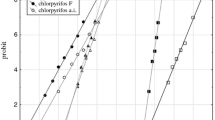Abstract
Studies conducted using laboratory and field bioassays showed that Cypermethrin (b=−1.691) had a significantly (P<0.05) higher and longer residual action at 7, 14, 21 and 28 days after application than did fenvalerate (b=−2.28) and permethrin (b=−1.871) against Dysdercus fasciatus Sign, and D. nigrofasciatus Stal. when coefficient regression analyses were performed. Residual action of fenvalerate and permethrin was regarded as being identical over the same experimental period in the field since their regression coefficients were not significantly (P>0.05) different from each other.
It was also shown by these studies that the effective interval between applications was 21 days for Cypermethrin and 14 days when fenvalerate and permethrin were applied. This finding has important practical implications in the adoption of an integrated approach aimed at minimizing damage to cotton by D. nigrofasciatus.
Résumé
Apres I’analyse par regression des données sur terrain, le résultats de I’expérimentation ont clairement montre que cypermethrine (b =−1.691) a un effet résiduel plus remarquable et qui dure longtemps (mortalité) á 7, 14, 21 et 28 jours après I’application, que fenvalerate (b =−2.028) et permethrine (=−1.81) contre Dysdercus fasciatus Sign, et D. nigrofasciatus Stal. L’áction résiduel de fenvalerate et permethrine est consideree être identique, parce que leurs coefficients ne differént pas largement lun de l’áutre (P=0.05).
L’étude a également montré que la páriods intervalle entre les applications était de 21 jours (fenvalarate et permethrine) tandis que pour le cas de cypermethrine, 14 jours suffisent.
Cette constatation a des implications practiques quant á I’adoption dune approche integree ayant I’objetif de minimiser les degats causés par D. fasciatus et D. nigrofasciatus sur le cotton, et en meme temps rendre minime le nombre d’applications de I’insecticide, et ceci également a un effet positif sur la qualite de lé environment, conserve les ennemies naturelles des pestes et finalement les fermiers sont en position d obtenir de bons rendements (récoltes optimales).
Similar content being viewed by others
References
Adam, C.F. (1982) Pest control for small cotton growers: The Hola experiment. Shell Agric. Bull. pp. 4–5.
Anonymous (1980) Annual report of Cotton Research Station, Kibos. Ministry of Agriculture, Kenya.
Anonymous (1982) The 1982 insecticide recommendations for cotton. Circular letter of Senior Kenya Government Entomologist. Ministry of Agriculture, Kenya.
Anonymous (1983) Annual report of Cotton Research Station, Kibos. Ministry of Agriculture, Kenya.
Bohlen E. (1973) Crop pests in Tanzania and their control. Verlag Paul Parey. Berlin and Hamburg.
Brown K.J., Rens G.R., Tveitnes S. and Aakerbakken U.N. (1972) Cotton growing recommendations for Kenya. Ministry of Agriculture, Kenya.
Busvine J. R. and Nash R. (1953) Evaluation of new contact insecticides. Bull, entomol. Res. 44, 371–376.
Crowe T.J. (1967) Cotton pests and their control. Department of Agriculture, Kenya Government.
de Pury J.M.S (1968) Crop Pests of East Africa. Oxford University Press, Nairobi.
Geering Q.A. (1956) A method for controlled breeding of cotton stainers, Dysdercus spp. (Pyrrhocoridae). Bull, entomol. Res. 46, 743–746.
Hill D. (1975) Agricultural Insects of theTropics and Their Control. Cambridge University Press.
Le Pelley R. H. (1959) Agricultural Insects of East Africa. E.A. High Commission, Nairobi, Kenya.
Mathews G. A. (1966) Investigations of the chemical control of insect pests of cotton in Central Africa. Bull, entomol. Res. 57, 69–91.
Mathews G. A. and Tunstall J.P. (1968) Scouting and timing of spray applications. Cott. Gr. Rev. 45, 115–127.
Muthamia J.B. (1971) Cotton pests and their control. Ministry of Agriculture Monograph.
Murega T. G. and Khaemba B. M. (1985a) The effect of the infestation by red spider mites, Tetranychus spp. (Acarina: Tetranychidae) attacking cotton in Eastern Kenya. Insect Sei. Applic. 6, 7–11.
Murega T.G. and Khaemba B.M. (1985b) Evaluation of some chemicals for efficacy against red spider mites, Tetranychus spp. (Acarina:Tetranychidae) attacking cotton in Eastern Kenya. Insect Sei. Applic. 6, 11–15.
Pearson E.O. and Maxwell D.R. C. (1958) The insect pests of cotton in tropical Africa. Cott. Res. Corp. and Commonwealth Institute of Entomology, London.
Tengecho B. (1984) The biological performance of Dysdercus cardinalis Gerst and Dysdercus fasciatus Signoret (Hemiptera: Pyrrhocoridae) on five different host plants. M.Sc. thesis, University of Nairobi.
Tunstall J.P. and Mathews G.A. (1966) Large scale spraying trials for the control of cotton pests in Central Africa. Emp. Cott. Gr.Rev. 43, 121–139.
Ware G.W. (1978) Pesticides: Theory and Application. W.H. Freeman and Company, San Fransisco.
Rens G.R. (1977) Cotton pests of Kenya. Ministry of Agriculture. Monograph, Kenya Government.
Schmutterer H. (1969) Pests of Crops in Northeast and Central Africa. Gustav. Springer Verlag, Stuttgart, pp. 66–72.
Author information
Authors and Affiliations
Rights and permissions
About this article
Cite this article
Khaemba, B.M., Mambiri, A.M. Studies on the Residual Activity of Three Synthetic Pyrethroids Cypermethrin, Fenvalerate and Permethrin Against Cotton Stainers, Dysdercus Spp (Hemiptera:Pyrrhocoridae). Int J Trop Insect Sci 10, 347–352 (1989). https://doi.org/10.1017/S1742758400003593
Received:
Revised:
Published:
Issue Date:
DOI: https://doi.org/10.1017/S1742758400003593
Key Words
- Bioassays
- Cypermethrin
- fenvalerate
- permethrin
- residual action
- Dysdercus spp.
- effective application interval




